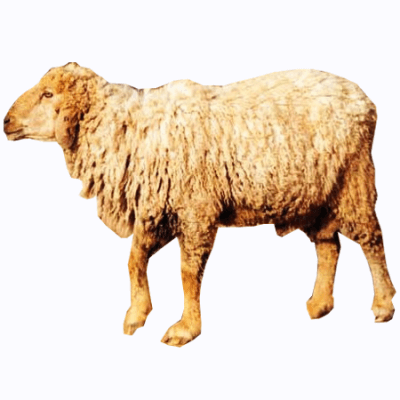
General Information
It is found in Jhunjhunu, Churu and Ganganagar districts of Rajasthan, Rohtak and Hissar districts of Haryana and Uttar Pradesh. It is a medium-sized animal. It has a light brown colour face, pink colour skin, medium and tubular ears, a short and thin tail and white and dense fleece. This breed is used for wool and meat production and is not used for milk production. The average wool yield is 1.5-3kg. The average weight of male sheep is 39kg and that of female sheep is 32kg.
Fodder
Sheep mainly like to graze and love to eat leguminous feed such as Lobia, Berseem, Cowpea etc. In fodders mainly cowpea/labia is given as feed to the animals as it is the annual plant and is served with a mixture of maize or sorghum. Sheep mainly graze in the field for 6-7 hours and require pasture or hay in their food diet. For grazing they required fresh green grass, especially timothy or canary grass.
Planted fodder: Podded: Berseem, Garlic, Beans, Peas, Guar.
Non leguminous: Corn, Oats.
Tree leaves: Peepal, mango, Ashoka, neem, berry and banyan.
Plants and bushes, herbal and climber plants: Gokharu, khejri, karonda, berry etc.
Root plants (Leftover material of vegetables): Turnip, potato, radish, carrot, beetroot, cauliflower and cabbage.
Grass: Napier grass, guinea grass, doob grass, anjan grass, stylo grass.
Dry fodder
Straw: Chickpea, pigeon pea and groundnut, conserved fodder.
Hay: Grass, leguminous (chickpea) and non-leguminous (oats).
Silage: Grass, leguminous and non-leguminous plants.
Distribution
Grain: Bajra, sorghum, oats, maize, chickpea, wheat.
Farm and industrial sub-products: Coconut seeds skin, mustard skin, groundnut skin, also, shisha, wheat sawdust, rice sawdust, etc.
Livestock and marine products: Full and partial dry milk products, fish meal, blood meal.
Industrial sub-products: Sub-products of barley, vegetables and fruits.
Pods: Acacia, banyan, peas etc.
Care of the breed
Care of pregnant sheep: Proper care of their feed and management must be taken to avoid abortions, premature births and toxaemia. Protect ewes from cold weather and provide them with a clean and separate room/area before 4-6 days of parturient. The feed quantity should be increased in the later stages of pregnancy i.e. 3-4 weeks before the parturient which helps them to produce increased milk production and healthy lamb growth.
Care of weaner: After birth clean the nostrils, face and ear with the help of a dry cotton cloth and remove the placental membrane. Gentle rubbing must be done to clean the newborn kids. If a new born kid is not taking a breath then hold the kid up with their hind legs having head downwards which will help to clear their respiratory tract. Clean the udder of the weaner with tincture iodine and then give it its first colostrum drink within 30 minutes of its birth.
Care of lambs: Extreme care must be taken at the early stages of their life. Provide lambs with good quality hay or feed which is good for their health and is easily digestible. For nibbling, provide them with leguminous fodder or fresh leaves.
Organizing identification symbols on sheep: For the proper record, good husbandry, recognition purpose and proof of ownership it is necessary to apply a number mark on their body. It is mainly done with the help of tattooing, tagging, wax marking crayons, spray chalk, coloured spray and paint branding.
Recommended vaccination to lambs: In the first month of lamb, drenching must be done to protect them from gastrointestinal parasites and vaccination must be given to protect them from sheep-pox and enterotoxemia.
Diseases and Treatment
• Acidosis (Grain Overload): The disease occurs due to overeating of wheat or barley. The disease damages the rumen of the animal.
Treatment: If symptoms are seen then treat with the dose of sodium bicarbonate @10g/sheep.
• Annual Ryegrass Toxicity (ARGT): The disease is caused due to eating Annual Ryegrass. The infected seeds are eaten by sheep which is toxic to their health. This will cause the death of the animal. It mainly occurs from mid-October to mid-December.
Treatment: Take animals to different places if in surrounding the ryegrass is grown.
• Cheesy gland: It is a bacterial infection that causes the accumulation of pus in the lungs or lymph nodes which results in poor wool production.
Treatment: Vaccination of clostridial medicine is given to cure this disease.
• Cobalt deficiency: This disease mainly occurs due to the deficiency of B12 in the sheep.
Treatment: Immediate injection of vitamin B12 is given when symptoms are seen.
• Coccidiosis: This is a parasitic disease that damages the intestinal wall of sheep. This will cause the death of sheep.
Treatment: Two doses by drenching of the sulpha drug are given at intervals of 3 days or the injection is given.
• Copper deficiency: It occurs due to a deficiency of copper. This deficiency results in abnormalities in sheep.
Treatment: The capsules of copper oxide or injections of copper glycinate are given to cure copper deficiency.
• Dermatophilosis (Dermo or Lumpy Wool): Mainly Merino sheep suffer from this disease. Mainly the infection is seen in non-woolen areas.
Treatment: The antibiotic treatment will help to cure Dermatophilosis disease.
• Exposure loss: This is mainly occurring within 2 weeks of shearing as the sheep can’t maintain its normal body temperature because of heat loss.
Treatment: The sheep must be weather-protected.
• Foot Abscess: This disease occurs mainly in the rainy season. The bacterial infection infects the toe.
Treatment: Antibiotic treatment is given to get rid of the foot abscess.
• Listeriosis (Circling disease): It is a sporadic bacterial infection that affects animals and also humans. In flocks, the disease occurs because of eating spoiled hay.
Treatment: Antibiotic treatment is given by the vet.
• Pinkeye: It mainly occurs due to polluted surrounding environment.
Treatment: Antibiotic sprays or powder is given to get rid of pinkeye.
• Mastitis: In this disease the udder gets swollen or enlarged, milk becomes watery and the level of milk secretion gets reduced.
Financial and Business expert having 30+ Years of vast experience in running successful businesses and managing finance.





